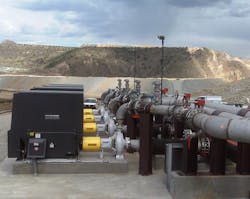Increased efficiency and safety in mine water management
Pumps play a critical role in all mining operations and are, therefore, among the most important equipment in a mine. Water enters mines from different directions as rain, meltwater or groundwater. And the operation of a mine also requires that water is supplied to various processes.
“Large volumes of water must be transported to and from several processes in a mine. If the pumps stop, the mine will flood, so it is critical for the continuous operation of a mine that the pumps are working as they should. The most important task of the pumps is to keep the mine dry,” says Mikael Hjelm, business development manager for mine water management at Sulzer, who has more than 30 years of experience with pumping solutions for mining.
In an underground mine, there can be hundreds of pumps in different applications — for example, drainage pumps, process pumps or high-pressure pumps. Drainage pumps are often used to transport water from the mining and blasting area via various sumps to the mine's main sump that is generally located at the lowest point of the mine. From there, the water is pumped with large drainage pumps to the mine's main pumping station. There, multi-stage, high-pressure pumps are used to transport the water in one or more steps to the ground level.
In shallower mines, end-suction process pumps can be employed, either as single units, or arranged in series, to reach higher heads. The pump type for such an application depends very much on the quality of the water that is pumped ─ whether it is clean or whether it contains solids. Multi-stage pumps are often the preferred choice when the water is clean, and end-suction process pumps are selected when the water contains solids.
In opencast mines, a combination of different technologies for water transport is used, ranging from drainage or process pumps to high-pressure, multi-stage pumps or other technologies, much depending on the flow and head required, as well as on the consistency of the liquid.
Pumps, mixers and agitators are needed in many processes and applications in a mine, and companies such as Sulzer can offer a wide range of suitable products and solutions.
“When a mine is established, the pump system is designed based on the volumes and quality of the water that will be handled, the expected service life of the mine, as well as its size and depth. The service life of the mine determines whether temporary or permanent pump solutions are chosen,” says Hjelm.
The pump technologies are relatively similar to the ones used 30 years ago, but as mines become deeper, the pumping heads grow. Deeper mines also place greater demands on the management of the water flow in the mines, and safety aspects have become very important.
Today, the focus is also on sustainability and energy costs. Higher efficiencies, a longer service life and improved material technology are called for in modern mining operations. In mine water management, requirements are imposed on efficient management and resource utilization, on water purification processes, and on reuse. The ever-deeper mines also require higher pump capacities than in the past.
“Modern pumps are often designed to reach high pressure heads. A good example is Sulzer’s latest launch in this field, the XJ 900, a 90-kW drainage pump that can manage a pressure head of more than 200 m. We also have multi-stage pumps that can handle a head of almost 2,000 m. The innovative design of the XJ 900’s hydraulics enables two pumps in one. No time-consuming or costly replacement of impellers and diffusers is required to convert a high-volume pump to a high-pressure pump and vice versa. The XJ 900 can be converted with a few simple steps, quickly and smoothly,” Hjelm says.
The digitalization and automation of mines also affects pump companies. For example, Sulzer follows developments closely and can provide several different solutions for the remote monitoring and controlling of pumps. In that area, Sulzer offers one of the most sophisticated solutions on the market with the built-in Aquatronic unit that integrates electronic intelligence into drainage pumps. It ensures correct motor rotation by automatically adjusting for wrong phase order. The unit also protects the motor by stopping the pump in case of overcurrent, overheating, low or high voltage, or a missing phase. In addition to this, Aquatronic is equipped with a diagnostics program that shows how the pump has been working, and faults can be easily diagnosed.
Further developments include a wireless condition monitoring systems, such as Sulzer Sense, that are easy to apply and use on both new and existing equipment. Customers can easily connect a large number of pumps to a network that gives the operator the opportunity to track the condition of the product, view the equipment trend data, access the latest technical product documentation and identify spare parts. This information is easily accessible on a computer or a mobile app.
“We need to adapt to new conditions. Mining companies are automating and digitalizing their mines and autonomizing most vehicles and equipment for increased efficiency, productivity and safety. In the long run, the number of employees working down in the mines will decrease. Instead, the operation will be managed from control rooms at ground level. This is where we can help companies with digital solutions to control and monitor their equipment,” Hjelm says.
Sulzer is a global leader in fluid engineering. The company specializes in pumping, agitation, mixing, separation and application technologies for fluids of all types. Sulzer provides pumps, agitators, compressors, grinders and screens developed through intensive research and development in fluid dynamics and advanced materials, and is a market leader in pumping solutions for water, oil and gas, power, chemicals and most industrial segments.
About the Author
Mikael Hjelm
Business Development Manager for Mine Dewatering at Sulzer
Mikael Hjelm is the Business Development Manager for Mine Dewatering at Sulzer.


